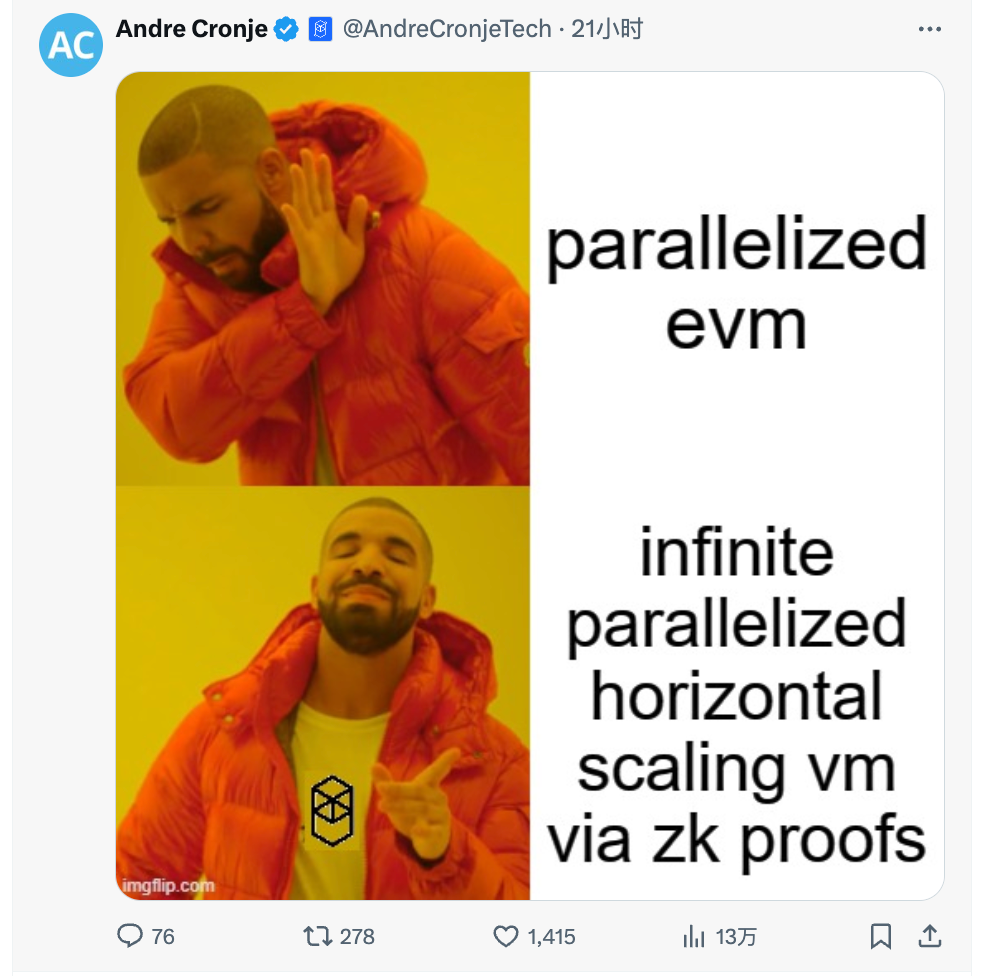Original author: Shenchao TechFlow
Fantom seems to be bucking the trend.
Against the backdrop of the overall major correction in the crypto market in the past week, the price of FTM has been spiraling upward, breaking through to a new price high in the past year.
The soul of Fantom, the star AC (Andre Cronje) of the last round of DeFi Summer, has returned, calling orders frequently on X, and even created a new MEME primitive:

The protagonist of the meme is Fantom Sonic, which means punching and kicking parallel EVM, implying that its performance is even better.
AC stated bluntly:
Parallelization doesnt even rank high among the benefits of our technology improvements.
On one side, the parallel EVM narrative of high-performance new L1s such as Monad and Sei is being sought after by the market, and on the other side is the strong rebound of old L1s such as Solana and Avalanche;
In the L1 war, Fantom is more like a hidden gem in the ocean. It is not among the hot spots, but it is not outside the competition.
And as the spring launch of the Fantom Sonic mainnet approaches, will this become a key catalyst for FTM to start a surge mode?
Faster than parallel EVM?
What is Fantom Sonic?
In short, Fantom Sonic is a new generation of Fantom network that will replace the previous Fantom Opera and can be understood as Fantom 2.0.
Fantom Opera includes a new client, validator, virtual machine (FVM), Carmen database and optimized Lachesis consensus mechanism, which will greatly improve the execution efficiency of the original Fantom.
Existing smart contracts on Fantom Opera are fully compatible with Fantom Sonic because FVM is fully compatible with EVM and its programming languages (Solidity, Vyper).
In fact, Fantom Sonic didnt just pop out of nowhere recently.
As early as the end of October last year, the Fantom Foundation had officially announced the launch of Sonics testnet; and in its plan, the mainnet will be officially released this spring. It is now late March, and the market has naturally increased hype expectations.
No matter how the story of L1 is told, there is only one core point that it wants to convey---my homes performance is better.
Judging from the testnet data and materials currently disclosed by Fantom Sonic, its selling point is also very obvious, that isIt focuses on faster speed and stronger performance than all current EVMs.
The data disclosed by AC on social media is:
Now based on EVM, the theoretical upper limit is about 200 transactions per second. By adding optimistic parallelization, it can increase by 40 transactions, reaching a maximum of about 240 transactions per second;
But based on the new FVM, the theoretical upper limit is about 30,000 transactions per second. Even if parallelization technology is added, the number of transactions per second can only be increased by 4,500.

The implication is that the performance of Fantom Sonic is already good enough, and with the so-called parallelization, there is not much room for improvement.
Follow your own path of performance improvement and disdain parallelization. How do you do this?
If you want to improve the performance of L1, you need to work hard to optimize the following aspects: the environment for executing transactions, the environment for storing transactions, and the method of reaching consensus.
The answers Sonic gave in these aspects are:
FVM :While being compatible with EVM, it provides an environment for executing smart contracts faster than the old EVM, improving execution efficiency;
Storage environment:The introduction of the Carmen database storage solution is equivalent to installing an intelligent indexing system in the archives, which greatly improves the data access efficiency and reduces the required storage space by 90%. Providers running RPC services can achieve this through multiple archive nodes. Costs dropped by 95% (cost efficiency increased by 20 times).
Consensus algorithm:Fantom initially adopted Lachesis, a leaderless asynchronous Byzantine fault-tolerant (aBFT) consensus mechanism, which has good consensus efficiency. In the Sonic update, the Lachesis algorithm has undergone further optimization, reducing information redundancy in the network and improving decision-making. efficiency. This not only speeds up the transaction confirmation process, but also increases the overall throughput of the network.
We may not necessarily fully understand and study the specific details of these technology stacks, but in an encrypted environment where narrative significance and attention are greater than the technology itself, the core of Fantom Sonic can be simply understood as: Faster and Stronger .
And some public data also confirm this substantial improvement in performance.
In Sonics current design, the testnet is divided into two categories. One type is a closed test network, which is used to show the upper limit of performance that Sonic can achieve in an ideal environment; the other type is a public test network, which can simulate the performance results of actual applications in an environment that connects and interacts with the outside world. .
From the end of October last year to January this year, Fantom officially conducted multiple rounds of tests on Sonics closed test network to simulate the influx of real users, Sonics response to traffic pressure, transaction confirmation, TPS, token exchange and transfer, etc. Performance of commonly used functions.
The results show that by simulating the entry of real traffic and performing various actions, Sonic can support 2000 TPS and has an ultimate consistency of about 1 second (from the time the transaction is submitted to confirmation that it is finally valid and will not be changed, it only takes about 1 second).
Although this is only theoretical data from closed testing, for comparison, the final consistency of Ethereum is actually about 1.5-3 minutes. Solana can also achieve it in seconds, but the TPS it can support per second is not as good as Sonics test data.
If it only processes swap transactions, Sonics theoretical data is 4,000 TPS, and the final consistency is about 1.3 seconds; if it only processes transfers, the situation will be even more exaggerated - 10,000 TPS, and 1.6 seconds of final consistency.
Pure test data does not have much reference significance. It can be understood more as Fantom Sonics flexing muscles, and the actual user experience is more convincing.
On another Sonic public testnet, we can see a maze-like gameFull chain game, you need to control the green dot to get out of the game board to win.
Every step is an on-chain interaction. In my experience, I did pull up my wallet and sign every time I moved.
It is worth mentioning that from receiving test coins to constantly taking one step and interacting once, the confirmation time for each step of the entire process is only about 1-2 seconds; if the main network can achieve such a fast experience, it will support full-chain games or More high-frequency interactive Dapps will have a lot of room for imagination.
Sonic Labs was established, AC personally guided the ecological project
No matter how fast Sonic is, having ecological projects running on it is the key.
In order to cope with the improvement of technology and performance, the Fantom Foundation also established a new organization called Fantom Foundation at the end of December last year.Sonic Labs An incubator to help developers build innovative dApps in preparation for the Sonic mainnet.
The top 5 winners of application development will also get the opportunity to share 1,000,000 FTM tokens equally, as well as personal guidance from Andre Cronje. In addition, winners will receive guidance on technology, compliance, payroll and company structure from Pyth, Request Finance and the Fantom Foundation, and have the opportunity to raise funds from VC partners.
It can be said that the government has personally invested resources to support ecological projects.

In February of this year, Fantom officially announced the five winners of the above-mentioned activities, which naturally constituted new ecological projects worthy of attention after the launch of Sonic:
Lynx Protocol
A perpetual contract trading DEX that can use any token as collateral and provides 10 0X leverage
Twitter:@Lynx_Protocol
Official website:lynx.finance
The SocialFi project allows users to interact with the community through tickets (tradable social tokens).
Twitter:@ThunderDomeSoFi
Official website:thunderdome.so
Debita
A P2P lending platform that allows users to choose the required collateral, interest rates, etc. when seeking to borrow assets.
Twitter:@DebitaFinance
Official website:debita.fi
KiricCoin
Green tech startup that tracks and rewards individuals for their sustainable behavior to help combat climate change.
Twitter:@KiriCoin
Official website:kiritechnologies.com
Froqorion
A team role-playing game set in the ancient frog civilization Froqorion.
Twitter: @Froqorion
Official website:http://froqorion.com
Don’t pay for “fast”, pay for “making trouble”
Is the fast speed and strong performance currently demonstrated by Fantom Sonic the reason for the market’s Price in FTM?
Hyping technical narratives is of course the constant theme, but the L1 track has long passed the ancient stage of only telling TPS stories. Pure performance is not enough to gain a foothold in the fierce competition for attention, let alone Fantom It is not a new project like Monad itself.
On social media, some of Fantoms ecological projects are insinuating that L2 is complacent about the low gas fees of its transactions, and pointed out that Fantoms gas fees have actually been so low in the past four years.
And this just illustrates the key question: If the market only buys Fantom for its good performance, why does it not always have the spotlight on the encryption stage?
Obviously, technology is only the basis for narrative; whether the market can buy it and whether it can cause trouble is also crucial.
At this point, AC, the heart and soul of Fantom, has always been known to cause trouble. Fantom Sonics performance is certainly good, but the markets price in FTM must be a bigger bet on the next trouble of AC and its team; can he support ecological projects to find more ways to play? Playing a greater role in operations and communication are additional expectations for Fantom Sonic.
Paying not just for performance, but for doing things, is the tacit consensus among new and old leeks in the attention economy of the encryption market.
As for whether FTM will maintain its headwind breakthrough and whether Fantom Sonic will become the new winner in the L1 war, we have to wait and see.